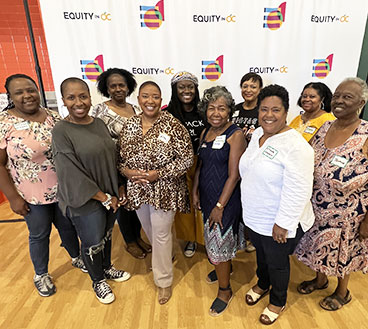Cancer – A Silent Killer for Blacks
By Dianne Anderson
Cancer – if only it could rear its ugly head before someone hits the late stages when they can still receive treatment, and live.
But typically, there are too few clues along the way. Sometimes, an unusual lump or a bump, but more likely, the problem is hidden and without pain.
“If you’re not getting your mammogram, prostate, and your annual checkups, it’s almost like a silent killer. There are very few symptoms,” said Kelita Gardner, Executive Director of Operations for Second Baptist Church in Santa Ana.
The answer can be found at their upcoming community-based health fair featuring a whole host of follow-up services and cancer screenings.
On Sunday, August 27, SBC Family Health and Wellness Fair will offer a full breakout of health access, flu shots, an Ask the Doctor inquiry booth, screenings and information on women’s health, prostate cancer, urology, physical and behavioral therapy. They also will have blood pressure, BMI and glucose screenings for diabetes.
The event runs from 9:00 a.m. to noon at Second Baptist Church located at 4300 Westminster Ave., in Santa Ana.
From a HEAAL perspective, their program saw a trend of people visiting their doctors on an average of 18 months, instead of every 12 months. Recently, Advance OC worked with HEAAL to release the first OC Health Equity Report.
Gardner said before the pandemic, disparities were a concern, but the report, the Impact of the Pandemic on OC Residents, is troubling. It shows the disproportionate impact on Blacks overall in the county, where Black males lost over five years of life expectancy, with cancer as one of the leading causes.
“When we dug deeper, we found that part of that [access] is the copay,” Gardner said. “The cost is so expensive in their insurance, they had to make real life choices whether or not to pay the copay or dealing with the rent or immediate needs.”
Not everybody qualifies for Covered California. Of those surveyed, many had private insurance, meaning they ended up waiting to go to urgent care when the symptoms showed up usually at the later stages.
“It’s less expensive for them to go to the emergency room than go to the doctor, as opposed to testing and diagnosis,” she said.
In another report, “Cancer Facts & Figures for African American/Black People 2022-2024,” the American Cancer Society cites structural racism as the underlying source of health disparities. Also, how discrimination spills over to institutions, limits wealth, access to jobs, education, housing, healthy food, and quality health care.
Historic redlining was also a major driver for health disparities, preventing across the board access. Lending bias was associated with an increased risk of late-stage cancer diagnosis and two times higher breast cancer mortality rates than in other areas.
“For most cancers, Black people are more likely than White people to be diagnosed with an advanced (regional or distant) stage, when treatment is usually more extensive and less successful,” the report said.
During and after the pandemic, cancer screenings declined for all populations, including Blacks, but the burden of prostate, breast and cervical cancer is much higher in Blacks than whites.
Dr. Jemal, senior vice president of ACS Surveillance & Health Equity Science Department, said another major issue, especially with breast cancer, is that follow-up is less likely after an abnormal case, including mammography in the Black community.
“If you look at breast cancer mortality, it’s 40% higher in black women than white women, despite Black women having a lower incidence rate. The same thing for prostate cancer, the burden is twice as high in [mortality] in Black men than white men,” he said.
He said the health impact is still striking.
“That’s something we should be working on,” he said. “It’s important that we advocate in the Black community for a return to screening.”
Low income earners have a higher cancer rate in the Black community, but it isn’t always related to socioeconomic status. Blacks and whites with similar education and income levels still see significant disparities in treatment.
But poverty remains a barrier to getting checkups or follow-ups, such as access to reliable transportation or insurance, and Blacks are still more under-insured or uninsured than whites.
“Blacks are 20% below the poverty level, compared to 7% of whites. In this country, if you don’t have insurance you are on your own. There is no real choice. Even if you have insurance the copay is a barrier,” he said.
As a solution, ACS has moved several policies forward to increase fair access, including colorectal screenings and services for those on Medicare with treatment for polyps, which was formerly in some instances out of pocket.
“American Cancer Society does a lot to advance public policy, the sister organization Cancer Action Network has lobbied for legislation signed three years ago to increase access in all screening areas, particularly around poverty and living wage,” he said.
In the recent American Cancer Society Facts Report, researchers stress that equal treatment reduces racial disparities. Those without health insurance are more likely to be diagnosed with advanced cancer with a higher risk of cancer death compared to privately insured.
For example, colorectal cancer patients with stage II disease who have health insurance are more likely to survive 5 years than uninsured people with stage I disease, the study shows.
Compared to other groups, Blacks have lower rates of cancer screening, and are less likely to access quality care.
“Black women are less likely to have screening at high-quality facilities, and to have access to digital breast tomosynthesis screening (or 3-D mammography), which has a higher detection rate and lower recall compared to older technology (digital mammograms),” the study said.
For Black men, the ACS recommends that Black men and men at high risk of prostate cancer start prostate screenings and tests at age 45.
While the numbers are still disturbingly high, they are getting better.
The prostate cancer death rate in Black men has dropped by more than 50%, from a peak of 82.1 deaths per 100,000 in 1993 to 36.6 deaths per 100,000 in 2019, similar to the decline among White men, according to the report.
“Factors that have likely contributed to the decrease include early detection through PSA testing, improved surgical and radiologic treatment, and the use of hormonal therapy for advanced-stage disease,” the report said. “However, rapid declines since the mid-1990s have slowed in recent years, likely reflecting the uptick in advanced disease. From 2015 to 2019, the death rate declined by 1.3% per year among Black men and by 0.7% per year among White men.”
For more information on HEAAL, see https://heaaloc.org/
For the latest ACS Facts and Figures report, see
https://bit.ly/3s8uJld
To see ACS CAN, see https://www.fightcancer.org/




